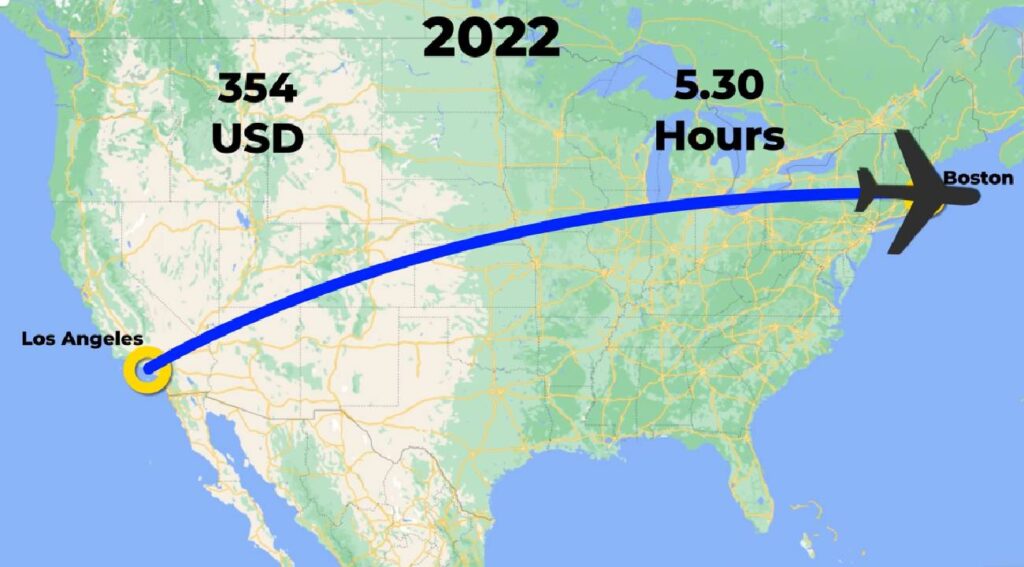Table of Contents
Air travel, once considered a luxury, is now within reach of the common man. At present, an aircraft not only transports passengers from one place to another but also provides a variety of amenities on the flight, such as legroom, TV, free WiFi, and cuisine made by celebrity chefs.
Even then, in the case of air travel from Los Angeles to Boston in the USA in 1941, the average price of a passenger’s ticket was more than four and a half thousand dollars ($ 4,539.24) at the current price, and the 12-stop flight took more than 15 hours.
On the other hand, five and a half hours of non-stop air travel at the same distance will cost a maximum of $354. Surprisingly, even 50-60 years ago, the cost of a passenger flight was about 110 percent higher than it is today. But, what exactly is the reason that air travel has become so cheap in recent times?
Overview
On 1st January 1914, in St. Florida, USA Pilot Tony Jannus conducted the world’s first 23-minute commercial flight from Petersburg to Tampa with a passenger. Originally, this fleet brick was the beginning of the journey of transcontinental flights worldwide. Although airships became popular for passenger air travel in the late 1920s and 1930s after World War I, passenger airships started losing popularity when the world’s giant passenger airship Zeppelin, LZ 129 Hindenburg, crashed during landing in New Jersey, the USA in 1936.

However, even though regular air travel was discontinued during the Second World War, rapid growth in the commercial aviation sector continued at the war’s end. Although at that time, the industry was controlled by the governments of different countries. When airline travel was deregulated around 1978, airlines were allowed to determine their flight routes, and since 1982, airlines have been allowed to set travel prices for themselves.
As a result, the number of private airlines continued to grow, and airlines began to follow competitive pricing strategies to attract passengers. As a result, the number of passengers on the airlines gradually started increasing. While the number of passengers in this industry was 297 million in 1980, it grew to 455 million in 1988.
Over the last 50 years, the industry has undergone significant changes and brought changes in its service. Where air flying was previously considered a luxury, it has now become much more affordable and accessible. Each flight can book in different price ranges, which are defined as fair codes or fair buckets. For example, in 1960 a flight from New York to London cost $300, the equivalent of $2,600 today.
But at present, it costs passengers a minimum of $1350 and a maximum of $1630 to cover the same distance. Due to this, the use of air travel has increased worldwide. According to Business Insider, about 45 million flights were recorded worldwide in 2018. According to Al Jazeera, about 4.5 billion passengers traveled on 42 million flights worldwide in 2019. However, due to the global pandemic, flights decreased to 24 and 26 million flights in 2020 and 21, respectively. However, the number of flights has now returned to normal.
Why So Cheap?


Efficiency Increased
Over time, planes have become more efficient due to the advancement of aircraft technology. Due to the implementation of new wing technology, the flying speed of planes has increased. As a result, a commercial aircraft can currently fly up to 4 times a day. The new technology has made the aircraft so efficient that it can fly 24 hours a day in case of emergency.
In addition, time management has further reduced customer ‘check-in-check-out’ time and brings efficiency from flights landing to departures. As operation time is one of the determining factors in increasing or decreasing the cost of a flight. Moreover, aircraft engineering has evolved so much over time that it improves the life cycle of each plane as well as ensures the satisfaction of the passengers. As a result, air travel has become a reliable source of transportation for the general public.
Availability
When this industry began, only a few significant cities worldwide had several airports. But as air travel gradually evolved into a common method of transportation, the number of airline companies as well as airports around the world began to increase. Aircraft are even being used to move from one city to another within a country, even on smaller islands. In other words, as air travel has become so much more affordable, the price has come down several times over the period.
Not a Luxury Anymore.
After World War II, military planes were redesigned and converted into commercial planes with passengers’ luxury in mind. With spacious cabins, dressing rooms, beverage lounges, and even a few different types of meals served, keeping in mind the luxury and comfort of the passengers. Moreover, air travel was only for the entertainment purpose of wealthy elite-class people.

However, as fair prices declined in 1940, airlines began to define passenger seats into four classes, with differences in ticket prices and service. Although the airlines’ profits are mainly generated from first-class and business-class ticket sales, the primary revenue sources of the companies in terms of economy of scale and revenue are especially economy class.
The more passengers it can carry on each aircraft For an airline, the more profitable it is. As a result, airlines keep economy class ticket prices low so that more tickets are sold, and the plane does not have to fly empty. As airlines follow a competitive pricing strategy to attract economy-class passengers, plane fares have steadily declined and become more affordable. As a result, air travel has become a significant means of travel nowadays.
Load Factor Increased
Load Factor refers to the percentage of an airline’s seating capacity for which the company can sell tickets. Due to the airlines’ competitive pricing strategy, their load factor increases day by day. And due to the increase in this load factor, the per-head-fixed cost also decreases.
The fixed cost of each airline flight is much higher than the variable cost. Such as Crew and Staff Member salaries, Fuel Costs, and Aircraft Maintenance costs. According to the New York Times, the width of each seat before airline deregulation has been reduced from 18 inches to 16.5 inches and the distance between each seat has been reduced from 35 inches to 31 inches.
Competition Increased
Competition between different airlines is much more noticeable in the world’s major airports. These airlines sell tickets at a minimum profit margin to retain passengers on a large scale. Various airlines also sell tickets at fair prices through online sites like Travelocity, Expedia, and BookingBuddy.

Later, these sites also set competitive pricing to attract customers. The sites show customers a list of low prices for higher prices tickets from which the customer can easily make price comparisons and choose the affordable option.
Even though sometimes it is difficult for state-owned airlines to achieve this minimum profit margin. Because they have to operate the business at a loss due to political instability, natural disasters, and terrorism. Sometimes state-owned airlines had to continue their operation even if they did not generate any profit. As a result, other private airlines have to compete with these airlines.
Buy On Board
Commercial aviation is usually operated on a buy-onboard system where ticket prices do not include the cost of added services such as baggage checking, boarding, food, and beverage. To avail of all these services, passengers have to select additional services during the on-board purchase or ticket confirmation.
Although these costs were previously included with the ticket price, these services were segregated to reduce ticket prices due to increased competition following the deregulation of the airline industry.
Alternative Revenue Streams
The revenue stream of airlines has changed drastically in the last few decades. Airlines used to generate most of their revenues by selling tickets to passengers, but now their frequent flyer programs have become a viable alternative source of revenue.
Initially, the airlines gave points to the passengers who were flying with them frequently under the Frequent Flyer program, but later they started giving these points to various associate partners like certain Rent-a-car service providers or staying at hotels. In this case, the airlines’ associate rent-a-car companies and hotels would give these points to the passengers, which these associates would buy from the airlines.
As a result, selling this point in the Frequent Flyer program has become a source of revenue for airlines. This revenue source became massive for airlines when airlines started issuing co-branded credit cards with various banks and card issuers. On co-branded cards, banks and credit card issuers offer users an airline point reward on purchases, which users can later redeem through seat upgrades or ticket purchases during air travel.
According to the LA Times, in 2016, four major US airlines generated about 10 (9.5) billion in revenue from the frequent flier program. Even the Frequent Flyer program is so profitable for airlines that, according to Forbes, among the major airlines in the USA, the value of the Frequent Flyer program of American Airlines and United Airlines exceeds the market cap of the original airline company.
| Airlines | Frequent Flyer Value | Market Cap |
| American Airlines | 23.44 Billion USD | 12.62 Billion USD |
| United Airlines Holdings | 20.17 Billion USD | 15.38 Billion USD |










Leave a Comment